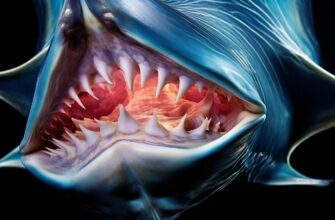Sharks are fascinating creatures that have captured our attention for centuries. With their sleek bodies and sharp teeth, they are the perfect predators of the sea. But have you ever wondered about the anatomy of a shark? Do they have tongues like other animals? In this article, we’ll explore the different aspects of shark anatomy, from their external features to their internal organs. We’ll also answer the burning question of whether sharks have tongues or not. So let’s dive in and discover the secrets of these magnificent creatures!
- Shark Anatomy: A Closer Look
- The Mouth of a Shark
- The Ampullae of Lorenzini
- The Internal Organs of a Shark
- The Tongue Mystery: Do Sharks Have Tongues?
- Other Fascinating Facts about Shark Anatomy
- The Frequently Asked Questions about Shark Anatomy
- Do sharks have bones?
- How many teeth do sharks have and how do they grow new ones?
- Why do sharks have such sharp teeth?
- How do sharks sense their prey?
- Do all sharks have the same kind of internal organs?
- Do all shark species have the same shape and size?
Shark Anatomy: A Closer Look
Sharks are fascinating creatures that have evolved unique adaptations to become apex predators in their respective environments. A closer look at their anatomy reveals some of their most impressive features.
| External Features | Internal Structures |
|---|---|
| Streamlined body shape for efficient swimming | Pairs of gills for breathing |
| Dermal denticles that resemble tiny teeth for protection and hydrodynamics | Large liver for buoyancy control |
| Pectoral fins for steering and maneuverability | Highly muscular stomach for digestion |
Sharks also have a unique sensory organ known as the lateral line system, which allows them to detect vibrations and movements in the water, even from long distances.
Another notable adaptation is the ampullae of Lorenzini, small pores on a shark’s snout that can detect electrical signals given off by other creatures. This helps sharks locate prey even in murky water or in low light conditions.
Overall, the anatomy of a shark is perfectly designed to meet the challenges of a predator’s life, making them one of the most efficient hunters in the ocean.
The Mouth of a Shark
The mouth of a shark is a remarkable piece of anatomy that has evolved to make these creatures some of the most successful predators in the ocean. Sharks have a set of powerful jaws that can open extremely wide, allowing them to swallow prey whole or take large bites out of larger animals.
One of the most distinctive features of a shark’s mouth is their rows of sharp, serrated teeth. These teeth are constantly being replaced throughout the shark’s life; new teeth are constantly growing to replace those that have been lost or damaged. This ensures that sharks always have a sharp, effective set of teeth at their disposal.
Sharks also have a unique system for moving their teeth. Unlike most animals, which grow teeth anchored to their jawbones, sharks have teeth that are loosely attached to their gums. Each tooth is supported by several smaller teeth, which act as a backup in case any one tooth falls out. As a tooth becomes worn or damaged, it can easily be replaced by a new tooth that moves forward to take its place.
Sharks use their mouths not only for eating, but also for sensing their environment. Along with their sharp teeth, sharks have specialized sensory organs in their mouths that can detect even the tiniest impulses in the water. These organs help sharks find prey even in murky or dark water, giving them an edge over other predators.
The Ampullae of Lorenzini
One such sensory organ is the ampullae of Lorenzini. These are specialized pores that are located around the shark’s mouth and snout, and they are filled with a gel that can detect electrical impulses. This allows sharks to sense the electrical fields given off by potential prey, helping them find food even when it is hidden from sight.
In addition to their sensory organs, sharks also have a powerful set of muscles in their jaws. These muscles are capable of exerting tremendous force, allowing sharks to bite through tough shells or even bone. Some species of shark can deliver a bite with a force of over 18,000 newtons – that’s strong enough to crush a bowling ball!
“The mouth of a shark is a remarkable piece of anatomy that has evolved to make these creatures some of the most successful predators in the ocean.”
Overall, the mouth of a shark is an incredibly complex and versatile organ that plays a vital role in the shark’s ability to hunt and survive. Whether biting into a tough shell or detecting the faint electrical impulses of hidden prey, a shark’s mouth is truly a marvel of nature.
The Internal Organs of a Shark
Sharks have an incredibly efficient internal system that allows them to swim and hunt with precision. Their organs have evolved to help them survive in some of the toughest environments on the planet.
One of the most remarkable features of a shark is their liver, which can make up a whopping 25% of their body weight. The liver is filled with oil that’s rich in squalene, a compound that helps the shark stay buoyant. This allows sharks to move up and down the water column with ease, conserving their energy and making them excellent hunters.
Sharks also have a unique circulatory system that’s designed to maintain their body temperature. Unlike most fish, sharks are able to regulate their internal temperature, which allows them to thrive in both warm and cold waters. Their circulatory system is more efficient than that of most other animals, and it helps them to conserve energy while swimming.
Another fascinating aspect of a shark’s anatomy is their sensory organs. Sharks have an incredible sense of smell, thanks to their olfactory organs. These are located in their nasal cavity, which is separate from their mouth. They can detect blood and other scents from miles away, allowing them to locate prey quickly and efficiently. Sharks also have a lateral line system that helps them to detect vibrations in the water. This system can help them locate potential prey, even in murky or dark waters.
Finally, sharks have a unique digestive system that allows them to break down and absorb every bit of nutrition from their food. Their stomachs are lined with acid-producing cells that can break down bones and other tough materials. They also have a spiral intestine that helps to maximize nutrient absorption.
The Tongue Mystery: Do Sharks Have Tongues?
One of the most intriguing questions about shark anatomy is whether or not sharks have tongues. The answer may surprise you!
While sharks do not have a traditional tongue like most animals, they do possess an anatomical structure known as the “basihyal.” This structure is located on the floor of the mouth and is used to help manipulate prey while feeding. While it may not look like a typical tongue, it serves a similar purpose.
Additionally, the basihyal is not the only unique feature of the shark’s mouth. Sharks are also known for their rows of sharp teeth and powerful jaws which allow them to catch and consume prey with ease.
So while sharks may not have a tongue in the traditional sense, the basihyal and other adaptations of their mouth make them one of the most formidable predators in the ocean.
Other Fascinating Facts about Shark Anatomy
In addition to their unique adaptations, sharks have many other fascinating features that contribute to their survival in the ocean. Here are a few more interesting facts about shark anatomy:
- Many sharks have a special organ called the ampullae of Lorenzini that can detect electrical signals from other animals. This helps them locate prey even in murky water.
- Sharks have multiple rows of replaceable teeth, which means that if they lose a tooth while hunting, a new one will quickly grow in to replace it.
- Sharks do not have a swim bladder like most other fish. Instead, they rely on their liver’s oil-filled buoyancy to stay afloat.
- Some sharks can have up to 7 gill slits on each side of their body, which helps them take in more oxygen from the water.
- Sharks have a unique type of vertebrae called “condyloid” vertebrae, which allows for greater flexibility and movement in their spine.
- The skin of a shark is covered in tiny scales called dermal denticles, which help reduce friction and drag as they swim through the water.
Overall, the anatomy of a shark is a remarkable display of evolution and adaptation. Their unique features have allowed them to thrive in the ocean for millions of years, and they continue to be fascinating creatures to study and admire.
The Frequently Asked Questions about Shark Anatomy
Here are the answers to some of the most commonly asked questions about shark anatomy:
Do sharks have bones?
Yes, sharks do have bones, but they are very different from the bones of other animals. Shark bones are made of cartilage, which is a flexible and durable tissue. This helps them to withstand the pressure of deep water and the stresses of hunting.
How many teeth do sharks have and how do they grow new ones?
Sharks have multiple rows of teeth that are constantly replaced throughout their lifetime. Some sharks can have up to 50,000 teeth in their lifetime! As older teeth fall out, new ones move forward to take their place.
Why do sharks have such sharp teeth?
Sharks have sharp teeth because they are designed to rip and tear flesh. Their teeth are serrated to better grip and slice through their prey, making them extremely effective hunters in the water.
How do sharks sense their prey?
Sharks have a series of sensory organs along their heads and bodies called ampullae of Lorenzini. These organs can detect electrical signals given off by other animals, allowing sharks to hone in on their prey even in murky waters.
Do all sharks have the same kind of internal organs?
No, while all sharks have similar internal organs like a liver and stomach, some species have unique adaptations. For example, the Greenland shark has a slow metabolism and can store large amounts of oil in its liver to help it survive in cold waters.
Do all shark species have the same shape and size?
No, there are over 400 species of sharks, each with its own unique shape and size. While some, like the great white shark, are large and torpedo-shaped, others, like the dwarf lantern shark, are small and slender.
With these answers, you should now have a better understanding of the fascinating anatomy of sharks.









